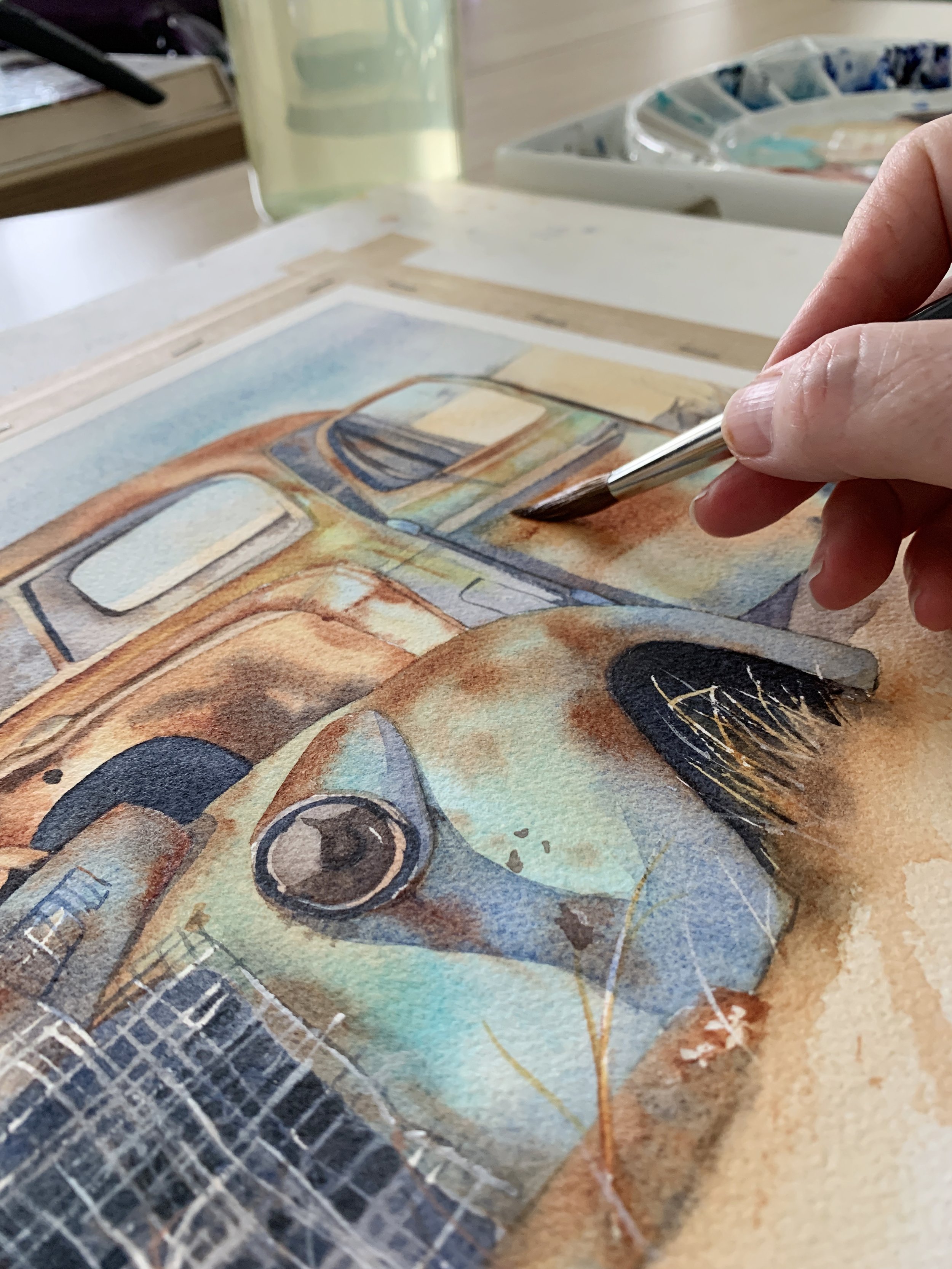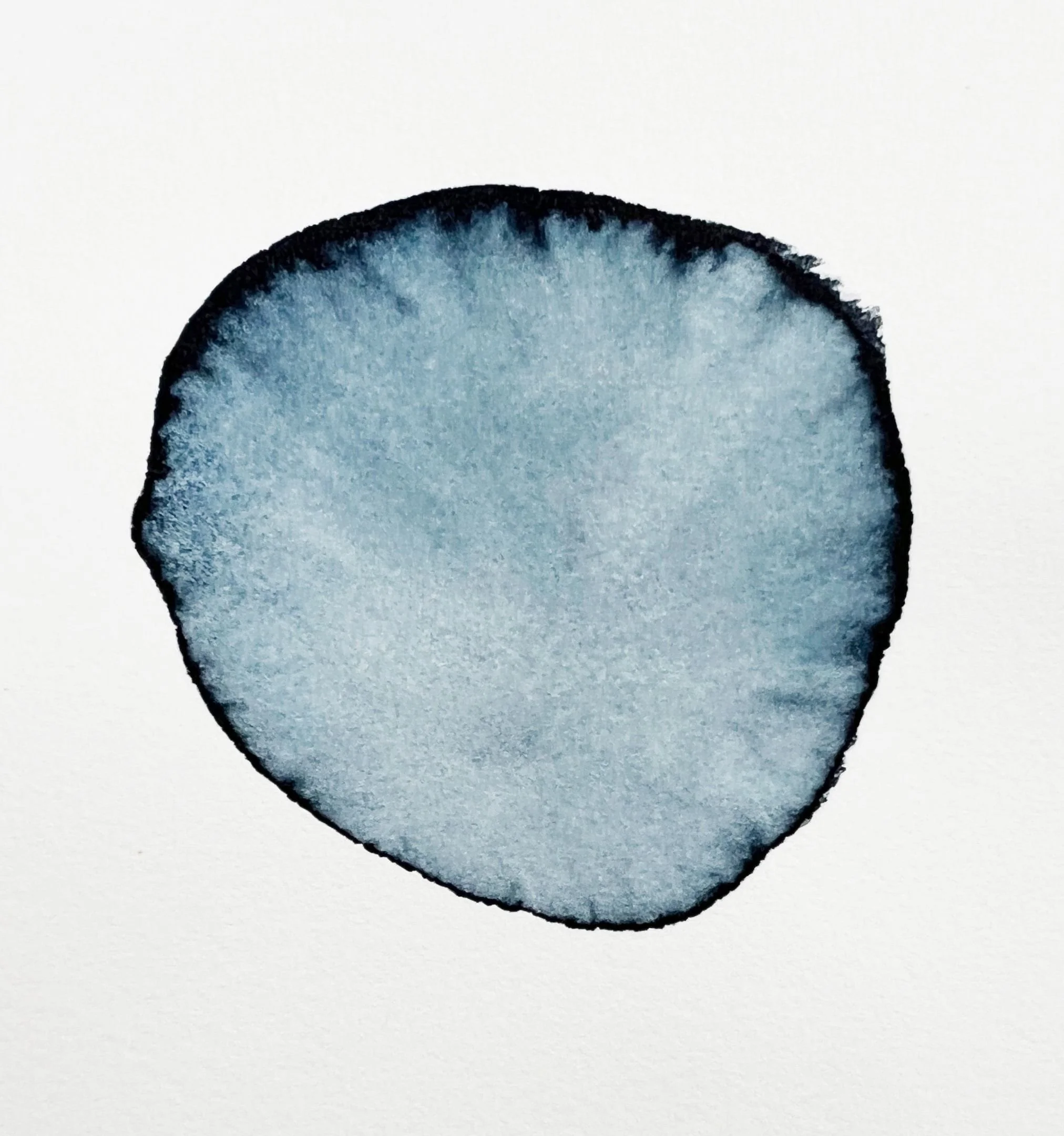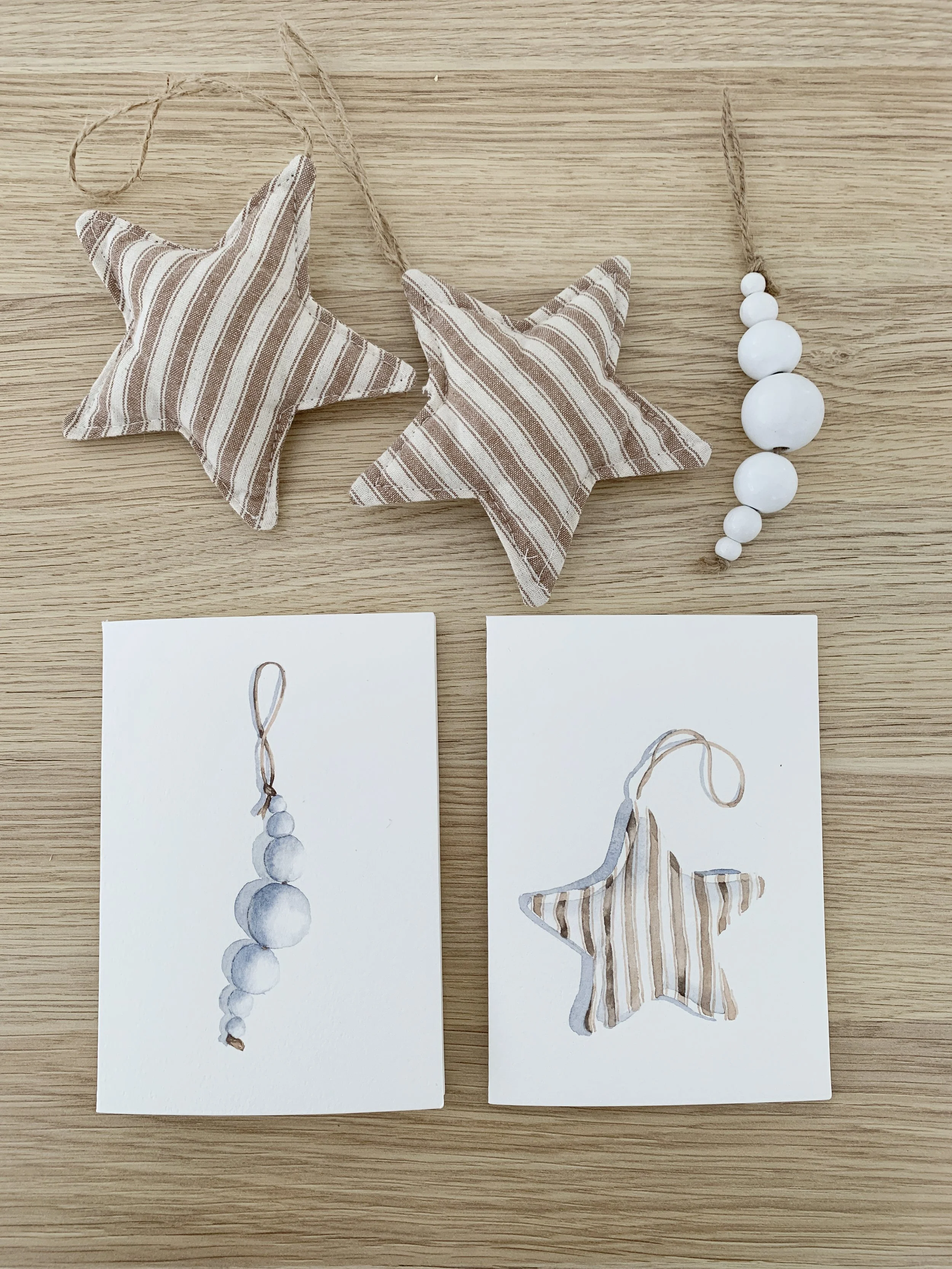Mastering Water Control in Watercolour Painting: A Comprehensive Guide
A watercolor painting of an old truck in a field (watercolor art by Louise De Masi)
Understanding the Basics of Water Control in Watercolour Painting
In watercolor painting, it's crucial to navigate the fine line between letting the paint flow freely and asserting control to ensure it adheres to your artistic intentions.
In this blog post, let’s embark on a journey to explore the nuances of water control in watercolour painting, a skill that transforms simple brushstrokes into expressions of emotion and beauty. Mastering water control is difficult, but not impossible to learn.
I have gathered the most crucial aspects of controlling water when painting in watercolour and encourage you to take the plunge and dive into watercolour art without fear.
The Role of Watercolour Brushes, Watercolour Paper, and Watercolour Paint
In watercolour painting, the interplay between the brush, paper, and paint is fundamental. The amount of water in your brush, the wetness of your paper, and the water content in your paint must be carefully balanced. Understanding how to use watercolour paint, brushes and paper and adjusting these elements can solve many common watercolour issues.
Importance of Quality Materials
Investing in high-quality watercolour materials is crucial. Good quality paints have more pigment and better lightfastness, ensuring longevity. Similarly, using 100% cotton watercolour paper enhances water absorption and control, reducing the likelihood of puddles.
100% Cotton Watercolour Paper
Good quality watercolour supplies are essential, particularly watercolour paper.
The choice of watercolour paper is important for success. I recommend 100% cotton watercolour paper for its superior water absorption and control. High-quality, 100% cotton cold press paper is not just a surface but a partner in your artistic journey. It absorbs water effectively, allowing you to weave your vision without the hindrance of puddles or unwanted bleeds.
There are other surfaces you can work on with watercolour, however, to achieve the most commonly used watercolour techniques, it’s of utmost importance to use great quality paper from the start – it will help your development. Papers that perform well for me are Arches and Fabriano Artistico.
Watercolour Brushes: More than just bristles
Learn to paint with good quality watercolor brushes. This is a selection of the round brushes I use.
Each watercolour brush in your arsenal is unique, holding a distinct amount of water and pigment. It's essential to understand their individual characteristics. Like getting to know a friend, familiarise yourself with each brush - their strengths, quirks, and how they interact with water. This understanding is fundamental in mastering watercolour.
Dip your brush in the wet paint and get to know what it can do.
Spend time with your watercolour brushes, observe their water retention, and learn their language. This understanding is the first step in mastering water control.
Watercolour Paints
Watercolor paint comes in a variety of different forms. There are pans, tubes, sticks and even watercolor pens.
There is a vast array of incredible watercolor manufacturers for you to choose from. Depending on where you live, one brand might be easier for you to come by, than another. I love Winsor & Newton paints, but due to not being able to source them reliably in Australia, I’ve recently made the switch to Schmincke pigments. If within your budget, opt for paints with strong pigments and lightfastness. Usually, the professional ranges provide these more reliably than student grade paints.
Watercolour paints can be transparent, semi-transparent, or opaque. Transparency affects how the paint layers and interacts with the paper or other paint colours, with transparent watercolours allowing light to pass through, creating luminous effects.
Watercolour Tubes, Pans, or Sticks – the difference between them
When thinking about what form of watercolour paints to use, there are a few things to consider: Using freshly squeezed tube pigment offers more control over the final colour and value.
Freshly squeezed pigment can provide more control over colour and value than pigments that have hardened on the palette. Dried or hardened paint on a palette may require more water to reactivate, which can affect the paint's consistency and value. Fresh pigment allows for quicker and more precise colour mixing.
Before I start painting I often squeeze some fresh tube paint onto my mixing palette.
Watercolour tubes
Tube paints are creamy and offer intense colour saturation. They are easily mixed with water to achieve various consistencies. When mixing colours, I prefer to use freshly squeezed pigment because I am more easily able to arrive at the colour and value I want quickly. When I try to mix with hardened paint on the palette, I tend to use too much water trying to get the value (darkness/lightness) of my mixture right. With fresh, wet paint, I can mix the colour and then adjust the value with water.
Mixing with fresh pigment on a watercolour palette.
Watercolour pans
These are solid blocks of watercolour paint, ideal for portability and plein air painting. They can be activated with water to achieve the desired consistency.
Watercolour pan paints are refreshed with clean water before starting a watercolour painting.
Liquid watercolour
Liquid watercolours provide vibrant, concentrated colours and can be diluted to a wide range of hues, suitable for experimenting with colour intensity.
Watercolour sticks
Stick watercolours, a newer form, offer versatility. They can be used dry or with a wet brush and as a drawing tool, providing different application methods.
Painting with a watercolor stick on wet paper.
Bringing paint to paper
Wetness and Consistency of Watercolour Paints
Working wet on wet. The paper is wet and the paint is wet and fluid.
Working wet on dry. The paint is wet and fluid but the paper is dry.
Understanding the amount of water on your brush and its interplay with the paper is vital. Watercolour techniques like dry-on-dry, wet-on-dry, wet-on-wet, and dry-on-wet are not just techniques; they are the essence of watercolour painting. Each watercolour method allows for a different expression of water and pigment, and mastering these can elevate your art.
Many beginners may not use enough water on their paper. The brush should glide effortlessly over the paper for most techniques, except for dry brushing. Adjusting the water level in the paint mixture or in your brush, can help achieve the right flow.
Paint-to-Water Ratio and Consistencies
The ratio of paint to water is crucial for achieving different saturation levels. Lighter colours often require more water, while darker tones are achieved with less water. Joseph Zbukvic, in his book "Mastering Atmosphere and Mood in Watercolor," introduced a framework of paint consistencies described as tea, milk, cream, and butter.
"Mastering Atmosphere and Mood in Watercolor" by Joseph Zbukvic
This approach helps artists gauge the thickness of their paint mixtures:
Tea Consistency
Highly diluted with water, perfect for light washes like skies.
Milk Consistency
Thicker than tea, ideal for areas that need more colour but still require some transparency.
Cream Consistency
Denser than milk, providing richer saturation and used for mid-tones or more substantial colour areas.
Butter Consistency
The thickest, often pure paint from the tube, used sparingly for deep, dark accents in a painting. In my tutorials, I often refer to butter consistency as paint freshly squeezed out of the tube.
In the photo below of the tiger watercolour painting I have used paint at butter consistency (fresh out of the tube) to paint the stripes. I needed the stripes on the tiger to be dark and I didn't want them to flow too much on the wet paper. I chose to use 'buttery paint' because it is thick and it stays in place on the wet paper.
Painting on wet paper gave the stripes soft edges. Using paint the consistency of soft butter meant the paint stayed in place on the wet paper.
Familiarise yourself with these consistencies as best as you can. By experimenting with these consistencies and understanding their impact on your artwork, you can create a diverse range of effects and enhance the depth and mood of your watercolour paintings.
How to Mix Watercolours
Start with a good amount of concentrated paint and add water gradually to achieve the desired tone. To lighten colours, add more water. This dilutes the mixture and utilises the whiteness of the paper for lightness. Avoid adding too much water initially, as it can make the mixture too watery and diluted.
You can try testing your mix on a practice sheet of paper prior to putting it on your artwork. Practice is key to mastering colour mixing and achieving the right hue and tone.
Mix the colour first and then adjust the value by adding water.
Useful tools and tips for water control
Swipe Off Excess Water
After dipping the brush in water or rinsing it, swipe off excess water from the bristles on the lip of the jar. This prevents large droplets from forming at the tip of the brush, which can interfere with control. Additionally, keep a towel beside you to adjust the water and paint load on your brush before you let the brush touch the paper. In time, you will know intuitively if your brush is too wet or too dry.
Avoid Puddles, Aim for Shine
Puddles on your paper can ruin your watercolour effects. Aim for a shiny appearance on the paper, which indicates the right amount of water. You can tilt the paper to check if the water is forming puddles. If it is sitting above the surface of the paper, forming puddles, dab away the excess with your brush or with a paper towel.
Wet paper evenly covered showing a glossy sheen on the paper. This is ready to accept the paint.
This paper is a bit too wet for most paint applications. The water is sitting above the surface of the paper, forming a puddle.
Water Temperature: A Subtle Influence
There's been a discussion amongst artists about the impact of water temperature on watercolour painting. While some experiments with warm water suggest a faster dissolution of paint, the overall effect on the finished artwork is minimal. The key takeaway here is to avoid extremes – too hot might damage your brushes and paper, while too cold could hinder paint flow. It's a bit like painting en plein air; whether it's a warm sunny day or a cool morning doesn't change the landscape, but it might change how you feel while painting it.
Creating and Managing Watercolour Blooms
I added some blooms to the bottom of the dog's red jacket to add interest to this painting.
Watercolour blooms are not just a technique, but an art form in themselves. They can add a dreamlike quality to your work. The trick is in controlling the water and understanding when to let it free. Blooms, where paint spreads out on the paper, can be aesthetically pleasing but challenging. Control the amount of water and paper's wetness to achieve or avoid this effect. I am planning a very detailed blog post just about watercolour blooms in the future, so keep an eye out.
Dealing with Tide Lines
Tide lines occur at the edge of a watercolour wash. To minimise them, feather the water edge with a brush or finish the water in a lighter-toned area. This requires careful manipulation of water and paint consistency. Proper control of water and paint consistency is crucial to manage tide lines.
Partially completed water colour painting showing unwanted tide lines
Special Techniques and Considerations
Working wet-on-wet longer
Gum Arabic
Ox Gall Liquid
Are you suffering from fast drying paper? If your watercolour paint dries faster than you can put it on you paper, adding Gum Arabic to your watercolour can slow the movement of the paint, allowing for greater control over bleeding and spreading. However, I found its use to be very limited. You can read more about my experiments with Ox Gall and Gum Arabic here.
I have found that wetting the paper twice is helpful in keeping your paper wetter for longer. You can wet the paper and then allow the sheen on the surface to diminish or flatten slightly and then wet it again before it dries completely.
Jacksons also offers a blending medium from Winsor & Newton, that seems to work very well – however, I haven’t tried it yet.
Embracing imperfections
In watercolour, not every stroke needs to be perfect. Sometimes, it's the imperfections - the unexpected drips, the unpredictable blends - that add character and life to your painting. Learning to work with and even embrace these moments is what makes watercolour so uniquely expressive.
Mastering water control in watercolour painting is a journey that requires patience, practice, and a deep understanding of your materials. It's about finding that sweet spot where control meets spontaneity, resulting in paintings that are not just seen but felt. By considering the interplay of materials and techniques and experimenting with various approaches, you can achieve a wide range of effects, from delicate washes to vibrant blooms.
Remember, every brushstroke reflects your relationship with water – respect it, understand it, and most importantly, enjoy the journey. So go ahead, let your creativity flow, and let the magic of watercolours bring your visions to life. Happy painting, and may your artistic journey be as fluid and beautiful as the watercolours on your palette! 🎨✨
If you are interested in learning to paint in watercolour, I have over 170 online, voiced over watercolour tutorials for all skill levels.
The old truck “Field Relic” print is available to purchase as a print in the shop.




























